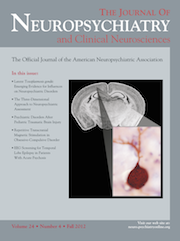Improvements in Micturition and Urinary Retention After Switching From Amisulpiride to Paliperidone in a Schizophrenic Patient
To the Editor: The influence of antipsychotics in micturition is an important issue for life quality of schizophrenic patients. Here, we share a case of a patient with schizophrenia, who suffered severe voiding difficult and urinary retention necessitating catheterization with the use of amisulpiride. The micturition problems were relieved after switching from amisulpiride to paliperidone.
Case Report
“Mr. Z” is a 45-year-old chronic schizophrenic patient with stable control of psychotic symptoms under the treatment of amisulpiride 600 mg/day for 4–5 years. In the last month, he has complained of a first episode of severe voiding problems, which included difficulty evacuating urine, frequently going to the toilet, but with no urinary output, and significant anxiety while facing difficult micturition. No significant changes in psychotic symptoms were observed. The urodynamic study revealed urinary retention and significant voiding dysfunction, with urethral sphincter spasm. He received the parasympathetic muscarinic stimulator buthanechol and selective alpha1A blocker tamsulosin to improve difficult voiding. However, the response was still limited, and he visited to our emergency department frequently because of the urinary retention; at last, he received urinary catheterization with a urine bag to relieve this problem. There were no concurrent psychotropic medications that might have contributed to the voiding dysfunction, such as anticholinergic medications or antidepressants, etc. No significant comorbid medical illness or substance abuse was noted. He also started to experience first episodes of severe anxiety caused by significant micturition problems. Because of the impression of possible antipsychotic-related micturition difficulty, the amisulpiride was switched to paliperidone (6 mg/day). After 2 weeks of treatment, he started to feel able to evacuate urine spontaneously and with less urinary retention. The accompanying anxiety was also decreased after improvements in voiding. No exacerbations of psychotic symptoms or intolerable side effects were mentioned after switching. The urodynamic study was reassessed at the third week after paliperidone therapy, and the results showed mild improvements in urethral sphincter spasm and urinary retention.
Discussion
The dopamine system is important for micturition, and dopamine D2 receptors are involved in the facilitation of micturition.1 Amisulpiride, a dopamine D2 receptor antagonist,2 might inhibit voiding ability because of the inhibition of D2 receptor-related micturition facilitation; 10% of urinary retention is associated with concomitant medications, including antipsychotics.3 Antipsychotics, such as clozapine, olanzapine, and haloperidol, have also been suggested to influence the inter-contraction interval, bladder capacity, bladder residual volume, micturition volume, external urethral sphincter function, and resting pressure of the bladder through the dopamine D2 antagonism and accompanying antimuscarinic effects.4–6 Ziprasidone is also reported to cause urinary hesitancy and urinary retention.7 In this case, urinary retention appeared after 4 years of amisulpiride use, which suggested that this patient might have changes of dopamine-receptor sensitivity and organic deteriorations of the urological system. The physiological evidence from the urodynamic study also supported this hypothesis. The urinary difficulties after treatment with paliperidone might be related to alpha1 antagonism, alpha2 antagonism, lack of anticholinergic effects, and serotonin 5HT7 antagonism.8–10 Although paliperidone also has D2 antagonism effects, paliperidone enters the brain less because of greater affinity for the P-glycoprotein,8 which might explain the relief of voiding dysfunction in this patient after using paliperidone. 5HT7 antagonism effects can also help relieve anxiety.11 Although amisulpiride also has 5HT7 antagonism effects, without anticholinergic effects, amisulpiride still lacks alpha-adrenergic antagonism, and its D2 antagonism might be higher than paliperidone because of the P-glycoprotein effects. These literature reviews may help us explain why this patient improved after using paliperidone, and this case report might provide us a clue about the urological side effects of atypical antipsychotics and the possible management of this issue.
1 : Role of dopamine D1 and D2 receptors in the micturition reflex in conscious rats. Neurourol Urodyn 2001; 20:105–113Crossref, Medline, Google Scholar
2 : Effect of antipsychotic medications on glucose and lipid levels. J Clin Pharmacol 2011; 51:631–638Crossref, Medline, Google Scholar
3 : Drug-induced urinary retention: incidence, management and prevention. Drug Saf 2008; 31:373–388Crossref, Medline, Google Scholar
4 : Effects of the atypical neuroleptic clozapine on micturition parameters in anesthetized rats. Neurourol Urodyn 2001; 20:623–639Crossref, Medline, Google Scholar
5 : Clozapine inhibits micturition parameters and the external urethral sphincter during cystometry in anesthetized rats. Brain Res 2001; 901:219–229Crossref, Medline, Google Scholar
6 : Effects of two atypical neuroleptics, olanzapine and risperidone, on the function of the urinary bladder and the external urethral sphincter in anesthetized rats. BMC Pharmacol 2001; 1:4Crossref, Medline, Google Scholar
7 : Urinary hesitancy and retention caused by ziprasidone. Int Clin Psychopharmacol 2006; 21:71–72Crossref, Medline, Google Scholar
8 : The pharmacokinetics of paliperidone versus risperidone. Psychosomatics 2010; 51:80–88Crossref, Medline, Google Scholar
9 : Single- and multiple-dose pharmacokinetics and dose proportionality of the psychotropic agent paliperidone extended release. J Clin Pharmacol 2009; 49:1318–1330Crossref, Medline, Google Scholar
10 : Upcoming agents for the treatment of schizophrenia: mechanism of action, efficacy, and tolerability. Drugs 2008; 68:2269–2292Crossref, Medline, Google Scholar
11 : The 5HT7 receptor and disorders of the nervous system: an overview. Psychopharmacology (Berl) 2009; 206:345–354Crossref, Medline, Google Scholar



